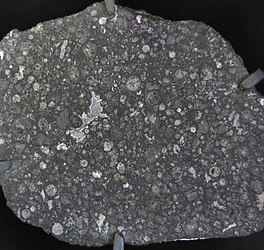Carbonaceous chondrites
| Carbonaceous chondrite | |
|---|---|
| — Class — | |

A slice of the Allende meteorite showing circular chondrules.
|
|
| Type | Chondrite |
| Alternative names | C chondrites |
Carbonaceous chondrites or C chondrites are a class of chondritic meteorites comprising at least 8 known groups and many ungrouped meteorites. They include some of the most primitive known meteorites. The C chondrites represent only a small proportion (4.6%) of meteorite falls.
Some famous carbonaceous chondrites are: Allende, Murchison, Orgueil, Ivuna, Murray, Tagish Lake, and Sutter's Mill.
Carbonaceous chondrites are grouped according to distinctive compositions thought to reflect the type of parent body from which they originated. These C chondrite groups are now each named with a standard two-letter CX designation, where C stands for "carbonaceous" (other types of chondrites do not begin with this letter) plus a capital letter in the spot X, which is very often the first letter of the name of a prominent meteorite — often the first to be discovered — in the group. Such meteorites are often named for the place where they fell, thus giving no clue as to the physical nature of the group. Group CH, where H is for "high metal" is so far the only exception. See below for name derivations of each group.
Several groups of carbonaceous chondrites, notably the CM and CI groups, contain high percentages (3% to 22%) of water, as well as organic compounds. They are composed mainly of silicates, oxides and sulfides, with the minerals olivine and serpentine being characteristic. The presence of volatile organic chemicals and water indicates that they have not undergone significant heating (>200 °C) since they were formed, and their compositions are considered to be close to that of the solar nebula from which the Solar System condensed. Other groups of C chondrites, e.g., CO, CV, and CK chondrites, are relatively poor in volatile compounds, and some of these have experienced significant heating on their parent asteroids.
...
Wikipedia
